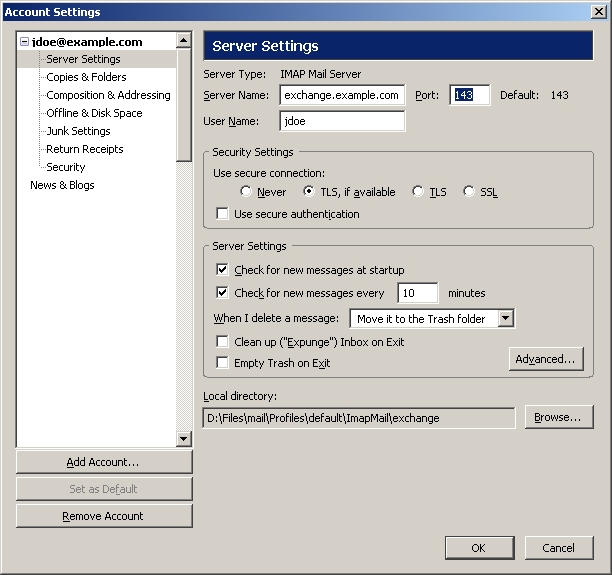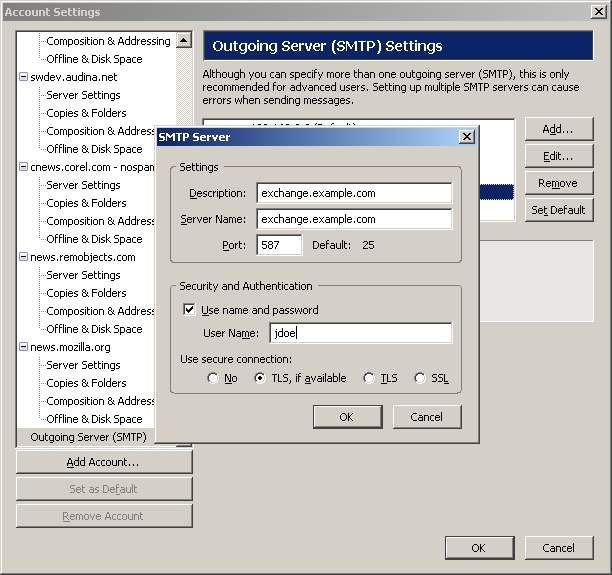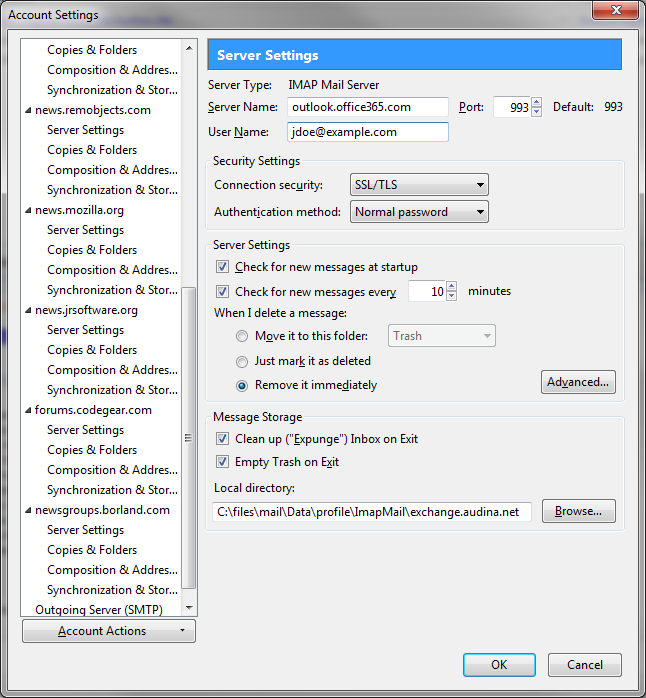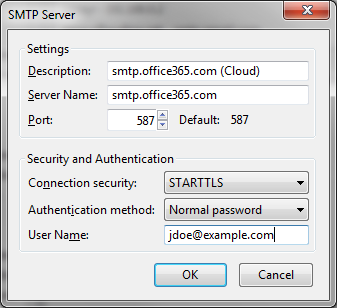Email with Thunderbird
Backing up your profile
Backing up your profile folder 1) in Thunderbird is easy. Just follow these steps (which assumes you know how to manage files on your computer):
- Shut down Thunderbird completely (File > Exit).
- Make a copy of your profile folder to, for example, a CD-RW disc or a separate hard disk for backup purposes.
Move an existing profile or restore a backed up profile
It is possible to move the location of a profile folder 2). This could be useful if you have a backed up profile folder somewhere on your hard drive and want to tell Thunderbird to use that as your profile. This section explains how to do this.
- Shut down Thunderbird completely (File > Exit).
- Move the profile folder to the desired location.
- On Windows XP, move the profile from
C:\Documents and Settings\[username]\Application Data\Thunderbird\Profiles\xxxxxxxx.defaulttoD:\Stuff\MyMailProfile. - On Windows Vista/7/8/10, move the profile from
C:\Users\[username]\AppData\Roaming\Thunderbird\Profiles\xxxxxxxx.defaultto desired folder (eg.:D:\Stuff\MyMailProfile). - To restore a previously backed up profile, this step isn't necessary. Just note the current location of the profile you want to restore.
- Open up
profiles.iniin a text editor. The file is located in the application data folder for Thunderbird:- On Windows Vista/7/8/10, the path is
%AppData%\Roaming\Thunderbird\ - On Windows XP/2000, the path is
%AppData%\Thunderbird\ - On Windows 95/98/Me, the path is usually
C:\WINDOWS\Application Data\Thunderbird\ - On Linux, the path is
~/.thunderbird/ - On Mac OS X, the path is
~/Library/Application Support/Thunderbird/
- In
profiles.ini, locate the entry for the profile you've just moved. Change the Path= line to the new location. If you are using a non-relative pathname, the direction of the slashes may be relevant (this is true for Windows XP). - Change
IsRelative=1toIsRelative=0. - Save
profiles.iniand restart Thunderbird.
Moving Extensions
The extensions are normally kept with the profile. To have extensions available after moving, perform the following:
- Edit
extensions.iniin profile folder to include all the correct paths forExtension0, Extension1…ExtensionN.
Accounts
Connecting to Exchange
To configure Thunderbird to receive mail using an Exchange server via IMAP, enter the following settings:
- Protocol: IMAP
- Port: 143
- Use Secure Connection: STARTTLS (or 'TLS, if available')
To configure Thunderbird to send mail using an Exchange server via SMTP (TLS), enter the following settings:
- Protocol: SMTP
- Port: 587
- Use name and password
- Use Secure Connection: STARTTLS (or 'TLS, if available')
For more tips, try Using POP3 and IMAP4 with Exchange
Connecting to Gmail-based Email Server
To configure Thunderbird to receive mail using the company's Gmail-based server via IMAP, enter the following settings:
- Server: imap.gmail.com
- Protocol: IMAP
- Port: 993
- Use Secure Connection: SSL
To configure Thunderbird to receive mail using POP3:
- Incoming Mail (POP3) Server - requires SSL: pop.gmail.com
- Use SSL: Yes
- Port: 995
To configure Thunderbird to send mail using the company's Gmail-based server via SMTP (SSL), enter the following settings:
- Server: smtp.gmail.com
- Protocol: SMTP
- Port: 587 or 465
- Use Authentication: Yes
- Use name and password: username@audina.net
- Use Secure Connection: SSL (port 465), or TLS/STARTTLS (port 587)
Connecting to Office365
- Server type: IMAP
- Server name:
outlook.office365.com - Port:
993 - User Name: < Full Email Address > (eg:
jdoe@example.com) - Connection Security:
SSL/TLS - Authentication method:
Normal password
- Server type: SMTP
- Server name:
smtp.office365.com - Port:
587 - User Name: < Full Email Address > (eg:
jdoe@example.com) - Connection Security:
STARTTLS - Authentication method:
Normal password
Migrating Mailboxes from Eudora to Thunderbird
- Compact Eudora mailboxes. Special > Compact Mailboxes.
- Convert Eudora mailboxes to mbox files using Eudora Rescue. Follow instructions in
ReadMe. Eg:C:\> C:\APPS\eudrescu.exe D:\EudoraMail -o=E:\Mail\Exported -x=.mbx
- Download Thunderbird 31.7 (38 or higher does not import Eudora mailboxes natively, since it contains a bug that does not recognize Eudora).
- Download and install Thunderbird add-on ImportExportTools. Tools > Add-ons > Search:
Import Export Tools, then 'See All'. - Verify (and install if missing) the registry entry pointing to Eudora mail and settings:
Windows Registry Editor Version 5.00 ; Adjust C:\\Path\\To\\Folder below so that it points to your Eudora data folder ; with your nndbase.txt and nndbase.toc files and/or your Nickname sub-folder ; 'Anything' is a keyword used in case the Eudora path and INI settings file is not written down ;[HKEY_CURRENT_USER\Software\Qualcomm\Eudora\CommandLine] ;"Current"="Anything C:\\Path\\To\\Folder Anything" ;"Current"="C:\\Path\\Eudora.exe C:\\Path\\To\\Folder C:\\Path\\Eudora.ini" [HKEY_CURRENT_USER\Software\Qualcomm\Eudora\CommandLine] "Current"="Anything C:\\Mail\\Export Anything"
- Run Thunderbird and create a mail profile.
- Create an
Archivesfolder under theLocalprofile. - Select
Archivesfolder then import mbox files: Tools > ImportExportTools > Import mbox files > Select a directory where searching the mbox files to import (also in subdirectories). After a few minutes, all the mailboxes should be present on theArchivesfolder. - Import address book from Eudora: Tools > Import > Address Books > Eudora. NOTE: For this option to work, use Thunderbird 31.7 or less, and Eudora registry entry must be valid.



